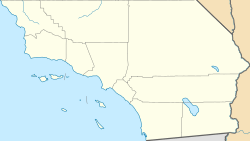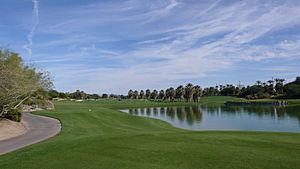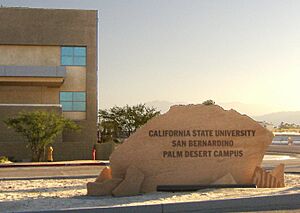Palm Desert, California facts for kids
Quick facts for kids
Palm Desert, California
|
|||
|---|---|---|---|
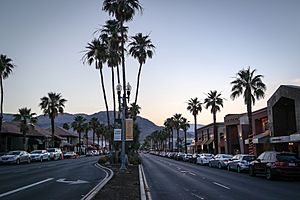
El Paseo in Palm Desert
|
|||
|
|||
| Nickname(s):
P. D., Palm Deezy
|
|||
| Motto(s):
"Feel The Warmth"
|
|||
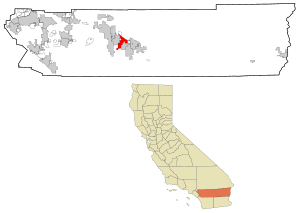
Location of Palm Desert, California
|
|||
| Country | United States | ||
| State | California | ||
| County | Riverside | ||
| Incorporated | November 26, 1973 | ||
| Government | |||
| • Type | Council–manager | ||
| Area | |||
| • Total | 27.02 sq mi (69.97 km2) | ||
| • Land | 26.81 sq mi (69.44 km2) | ||
| • Water | 0.20 sq mi (0.53 km2) 0.76% | ||
| Elevation | 220 ft (67 m) | ||
| Population
(2020)
|
|||
| • Total | 51,163 | ||
| • Estimate
(2022)
|
51,583 | ||
| • Density | 1,986.98/sq mi (736.85/km2) | ||
| Time zone | UTC-8 (Pacific) | ||
| • Summer (DST) | UTC-7 (PDT) | ||
| ZIP Codes |
92210, 92211, 92255, 92260, 92261
|
||
| Area codes | 442/760 | ||
| FIPS code | 06-55184 | ||
| GNIS feature IDs | 1652767, 2411356 | ||
Palm Desert is a city in California, located in the Coachella Valley. It's part of Riverside County. The city is in the Colorado Desert, which is a part of the larger Sonoran Desert. Palm Desert is about 14 miles (23 km) east of Palm Springs. In 2020, about 51,163 people lived here. It has been one of California's fastest-growing cities since 1980.
Contents
History of Palm Desert
Palm Desert is on the traditional land of the Cahuilla people. They have lived here for over 10,000 years. Their songs and stories tell about their long history in this area.
The area was first called Old MacDonald Ranch. In the 1920s, it became Palm Village because many date palm trees were planted. Before World War II, most people living here were Cahuilla farmers.
Big housing projects started in 1943. This was linked to General George S. Patton's Desert Training Center. The U.S. Army used this area for training during World War II. Later, this site became "El Paseo". It is now a fancy shopping area, much like Rodeo Drive. In 1948, the Palm Desert Corporation began building homes. The area got its current name, Palm Desert, in 1951.
In 1946, the Henderson brothers built the Shadow Mountain Club. It opened in 1948. This was one of the first large resorts in Palm Desert. It had a huge pool, a golf course, tennis courts, and a hotel.
Geography and Climate
Palm Desert covers about 27 square miles (70 square kilometers). Most of this area is land, with a small amount of water. The city is about 224 feet (67 meters) above sea level. Some parts of the city are lower, like old sand dunes. Other parts are higher, reaching up to 900 feet (274 meters). The highest ridgeline is about 1,000 feet (305 meters).
Palm Desert is in the Coachella Valley. This valley is the northwestern part of the Sonoran Desert.
Weather in Palm Desert
The weather in Palm Desert is very warm all year. This is because high mountains surround the valley on three sides. Winters are some of the warmest in the western U.S. Palm Desert has a hot desert climate. The average high temperature is 88°F (31°C). The average low is 64°F (18°C).
Summer highs often go above 108°F (42°C). Sometimes they can even reach over 120°F (49°C). Summer nights often stay above 82°F (28°C). Winters are warm, with daytime highs between 70-82°F (21-28°C). The city gets less than 3 inches (76 mm) of rain each year. It has over 348 sunny days annually.
The average yearly temperature is 76.0°F (24.4°C). This makes Palm Desert one of the warmest places in the country. The hottest temperature ever recorded was 125°F (52°C) on July 6, 1905.
| Climate data for Palm Desert, California (Indio Fire STN) elev. 10 feet (3.0 m) (1991–2020) | |||||||||||||
|---|---|---|---|---|---|---|---|---|---|---|---|---|---|
| Month | Jan | Feb | Mar | Apr | May | Jun | Jul | Aug | Sep | Oct | Nov | Dec | Year |
| Record high °F (°C) | 97 (36) |
100 (38) |
103 (39) |
109 (43) |
117 (47) |
123 (51) |
125 (52) |
121 (49) |
122 (50) |
115 (46) |
101 (38) |
93 (34) |
125 (52) |
| Mean daily maximum °F (°C) | 70.3 (21.3) |
73.3 (22.9) |
79.9 (26.6) |
85.8 (29.9) |
93.1 (33.9) |
101.7 (38.7) |
105.8 (41.0) |
105.2 (40.7) |
100.8 (38.2) |
90.5 (32.5) |
78.0 (25.6) |
68.8 (20.4) |
87.8 (31.0) |
| Daily mean °F (°C) | 58.6 (14.8) |
62.2 (16.8) |
68.5 (20.3) |
74.5 (23.6) |
81.2 (27.3) |
89.2 (31.8) |
94.1 (34.5) |
93.8 (34.3) |
88.7 (31.5) |
78.1 (25.6) |
65.5 (18.6) |
57.0 (13.9) |
76.0 (24.4) |
| Mean daily minimum °F (°C) | 46.8 (8.2) |
51.0 (10.6) |
57.2 (14.0) |
63.1 (17.3) |
69.3 (20.7) |
76.6 (24.8) |
82.5 (28.1) |
82.5 (28.1) |
76.5 (24.7) |
65.8 (18.8) |
53.0 (11.7) |
45.3 (7.4) |
64.1 (17.8) |
| Record low °F (°C) | 13 (−11) |
20 (−7) |
25 (−4) |
33 (1) |
38 (3) |
45 (7) |
59 (15) |
56 (13) |
46 (8) |
31 (−1) |
23 (−5) |
19 (−7) |
13 (−11) |
| Average precipitation inches (mm) | 0.65 (17) |
0.59 (15) |
0.32 (8.1) |
0.07 (1.8) |
0.02 (0.51) |
0.00 (0.00) |
0.05 (1.3) |
0.26 (6.6) |
0.13 (3.3) |
0.15 (3.8) |
0.19 (4.8) |
0.49 (12) |
2.92 (74) |
| Source: www.ncdc.noaa.gov | |||||||||||||
The mountains around Palm Desert create a special "thermal belt." This means that the southern foothills, like Cahuilla Hills, have warmer night-time temperatures in winter. The University of California has weather stations here. They study the environment at the Philip L. Boyd Deep Canyon Desert Research Center.
| Climate data for South Palm Desert, California elev. 980 feet (298.7 m) (Boyd Deep Canyon Ctr) 1981–2010 | |||||||||||||
|---|---|---|---|---|---|---|---|---|---|---|---|---|---|
| Month | Jan | Feb | Mar | Apr | May | Jun | Jul | Aug | Sep | Oct | Nov | Dec | Year |
| Mean daily maximum °F (°C) | 69.6 (20.9) |
72.0 (22.2) |
77.5 (25.3) |
84.6 (29.2) |
92.5 (33.6) |
100.8 (38.2) |
104.4 (40.2) |
104.0 (40.0) |
99.1 (37.3) |
88.7 (31.5) |
77.0 (25.0) |
68.5 (20.3) |
86.6 (30.3) |
| Daily mean °F (°C) | 60.4 (15.8) |
62.6 (17.0) |
66.8 (19.3) |
72.6 (22.6) |
79.4 (26.3) |
86.9 (30.5) |
91.5 (33.1) |
91.8 (33.2) |
87.5 (30.8) |
78.4 (25.8) |
67.5 (19.7) |
59.4 (15.2) |
75.4 (24.1) |
| Mean daily minimum °F (°C) | 51.1 (10.6) |
53.1 (11.7) |
56.1 (13.4) |
60.6 (15.9) |
66.2 (19.0) |
73.0 (22.8) |
78.6 (25.9) |
79.5 (26.4) |
75.9 (24.4) |
68.0 (20.0) |
57.9 (14.4) |
50.2 (10.1) |
64.2 (17.9) |
| Average precipitation inches (mm) | 0.86 (22) |
0.86 (22) |
0.56 (14) |
0.16 (4.1) |
0.07 (1.8) |
0.02 (0.51) |
0.44 (11) |
0.59 (15) |
0.53 (13) |
0.24 (6.1) |
0.44 (11) |
0.69 (18) |
5.52 (140) |
| Source: deepcanyon.ucnrs.org | |||||||||||||
People of Palm Desert
| Historical population | |||
|---|---|---|---|
| Census | Pop. | %± | |
| 1980 | 11,801 | — | |
| 1990 | 23,252 | 97.0% | |
| 2000 | 41,155 | 77.0% | |
| 2010 | 48,445 | 17.7% | |
| 2020 | 51,167 | 5.6% | |
| U.S. Decennial Census | |||
In 2010, Palm Desert had a population of 48,445 people. Most residents (82.5%) were White. About 22.8% of the population was of Hispanic or Latino background.
The city has many different types of households. About 18.4% of homes had children under 18. Many households (34.4%) were made up of single individuals. About 18.9% of those living alone were 65 or older. The average household had 2.08 people.
The population is spread out in age. About 15.6% of people were under 18. A large group, 32.9%, were 65 years or older. The average age in Palm Desert was 53.0 years.
Economy and Jobs
Palm Desert's economy relies a lot on tourism and hospitality. Many people work in hotels and resorts.
Top Employers in Palm Desert
Here are some of the biggest employers in the city:
| No. | Employer | No. of Employees |
|---|---|---|
| 1 | JW Marriott Desert Springs Golf Resort Marriott Desert Springs Villas |
2,304 |
| 2 | Universal Protection Service | 1,500 |
| 3 | Securitas | 700 |
| 4 | Avida Caregivers | 550 |
| 5 | Organization of Legal Pro's | 501 |
| 6 | Sunshine Landscape | 500 |
| 7 | Costco Wholesale | 250 |
| 8 | Big Horn Golf Club | 250 |
| 9 | Yellow Cab of Desert | 160 |
| 10 | Whole Foods Market | 150 |
Fun Things to Do
Palm Desert is home to Living Desert Zoo and Gardens. This is a special place with both a zoo and a botanical garden. It has over 500 animals from 150 different types. It also has a huge collection of desert plants. The Living Desert opened in 1970 and welcomes over 500,000 visitors each year.
Golf, Tennis, and Resorts
Palm Desert is famous for its many golf courses. There are about thirty golf courses in and around the city. This is why Palm Desert is sometimes called the "World's Golf Capital."
The city also has hundreds of tennis courts. These are both public and private. In recent years, Pickleball has also become very popular.
The first golf course and tennis club was Shadow Mountain, built in 1948. Later, many more resorts and hotels opened. The JW Marriott Desert Springs Golf Resort and Spa opened in 1987. The Desert Willow Golf Resort opened in 2002. Palm Desert has over 30 hotels and 5,000 rooms for visitors.
Sun City Palm Desert is a community for people aged 55 and older. It is just outside the city limits. It was built between 1992 and 2003.
Education in Palm Desert
Palm Desert has many schools and colleges. It is the main campus for College of the Desert, a community college. This college has grown a lot since it opened in 1962. One of its buildings was built with help from the local Cahuilla Indian tribes.
The University of California, Riverside also has a learning center here. California State University, San Bernardino opened its Palm Desert campus in 1986. In 2002, it got its own large campus. This campus offers many different college programs. It is the only full public university in the Coachella Valley.
The main high school is Palm Desert High School. It has about 2,200 students. The main middle school is Palm Desert Middle School, which is a charter school with about 1,100 students. There are four elementary schools: George Washington Charter, Abraham Lincoln, Jimmy Carter, and Ronald Reagan.
Some students in the northern part of Palm Desert go to schools in the Palm Springs Unified School District. This means they might attend Rancho Mirage High School or Cathedral City High School. Students in the east might go to La Quinta High School.
Palm Desert also has eight private schools. These include Desert Adventist Academy and Sacred Heart Catholic Academy. There is also Xavier College Preparatory High School. The Desert Torah Academy is a Jewish community school.
City Services and Transport
Utilities
Southern California Edison provides electricity to Palm Desert.
Transportation
Getting around Palm Desert and the area is easy.
- The Palm Springs International Airport serves the entire Coachella Valley.
- The SunLine Transit Agency offers bus service throughout the valley.
Major highways include:
 I-10: This interstate highway runs north of the city.
I-10: This interstate highway runs north of the city. SR 74: Also known as the Pines to Palms Scenic Byway. It connects the coast to Palm Desert.
SR 74: Also known as the Pines to Palms Scenic Byway. It connects the coast to Palm Desert. SR 111: This highway passes right through the city.
SR 111: This highway passes right through the city.
Parks and Nature
Palm Desert has 14 city parks for everyone to enjoy:
- Cahuilla Hills Park
- Cap Homme/ Ralph Adams Park
- Civic Center Park
- Community Gardens
- Freedom Park
- Hovley Soccer Park
- Ironwood Park
- Joe Mann Park
- Magnesia Falls City Park
- Palm Desert Dog Park
- Palma Village Park
- University Dog Park
- University Park East
- Washington Charter School Park
South of Palm Desert is the Santa Rosa and San Jacinto Mountains National Monument. To the north is the Coachella Valley National Wildlife Refuge. These are great places to explore nature.
Culture and Events
Palm Desert hosts many cultural events and festivals throughout the year. These include:
- Desert ARC Italian Festival
- Greek Festival
- Armenian Festival
- CanadaFest
- Scottish Festival
Places to Visit
Besides the Living Desert Zoo and Gardens, there are other cool places to visit:
- College of the Desert
- Philip L. Boyd Deep Canyon Desert Research Center (for nature lovers)
- McCallum Theatre (for shows and performances)
- Circle of Land and Sky (a temporary art display)
Nearby, you can also find:
- Children's Discovery Museum of the Desert in Rancho Mirage.
- Indian Wells Tennis Garden in Indian Wells.
Famous People from Palm Desert
Many well-known people have homes in Palm Desert. These include comedian Rita Rudner and professional golfer Michelle Wie. Bill Gates also has a home here. The late film producer Jerry Weintraub considered it his second home. Artist Phillip K. Smith III lives and works in Palm Desert.
Sister Cities
Palm Desert has connections with cities around the world through the Sister Cities program. These cities include:
- Wollongong, New South Wales, Australia
- Osoyoos, British Columbia, Canada
- Haifa, Israel
- La Paz, Baja California Sur, Mexico
- Gisborne, New Zealand
- Port Moresby, Papua New Guinea
- Port Elizabeth, South Africa
- Zihuatanejo, Guerrero, Mexico
Palm Desert also has a community exchange program with:
And a community exchange relationship with the city of Concepcion, Chile.
Images for kids
See also
 In Spanish: Palm Desert para niños
In Spanish: Palm Desert para niños




